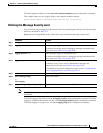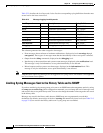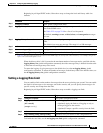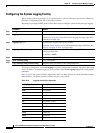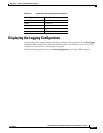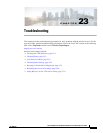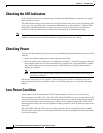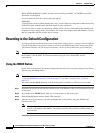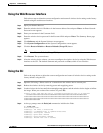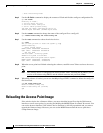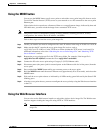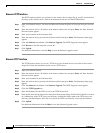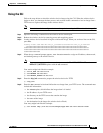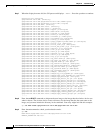
23-3
Cisco IOS Software Configuration Guide for Cisco Aironet Access Points
OL-30644-01
Chapter 23 Troubleshooting
Checking Basic Settings
Note An 802.3af compliant switch (Cisco or non-Cisco) is capable of supplying sufficient power for full
operation.
Note When an AP 2700 or AP 3700 is running in low power mode with PoE 802.3af power, one of the radios
is shutdown. As the saved power from the shut down radio is utilized for the running radio, that radio is
reset. During the reset, communication with associated WLAN clients will get disrupted. After the radio
comes back online after reset, the WLAN clients will re-associate with it afresh.
On power on, the access points are placed into low power mode (both radios are disabled), Cisco IOS
software loads and runs, and power negotiation determines if sufficient power is available. If there is
sufficient power then the radios are turned on; otherwise, the access point remains in low power mode
with the radios disabled to prevent a possible over-current condition. In low power mode, the access
point activates the Status LED low power error indication, displays a low power message on the browser
and serial interfaces, and creates an event log entry.
Checking Basic Settings
Mismatched basic settings are the most common causes of lost connectivity with wireless clients. If the
wireless device does not communicate with client devices, check the areas described in this section.
SSID
Wireless clients attempting to associate with the wireless device must use the same SSID as the wireless
device. If a client device’s SSID does not match the SSID of an wireless device in radio range, the client
device will not associate.
WEP Keys
The WEP key you use to transmit data must be set up exactly the same on the wireless device and any
wireless devices with which it associates. For example, if you set WEP Key 3 on your client adapter to
0987654321 and select it as the transmit key, you must set WEP Key 3 on the wireless device to exactly
the same value. The wireless device does not need to use Key 3 as its transmit key, however.
Refer to Chapter 10, “Configuring WLAN Authentication and Encryption,”for instructions on setting the
wireless device’s WEP keys.
Security Settings
Wireless clients attempting to authenticate with the wireless device must support the same security
options configured in the wireless device, such as EAP or LEAP, MAC address authentication, Message
Integrity Check (MIC), WEP key hashing, and 802.1X protocol versions.
If your radio clients are using EAP-FAST authentication, you must configure open authentication with
EAP. If you do not configure open authentication with EAP, a warning message appears. If you are using
the CLI. the following warning appears:



